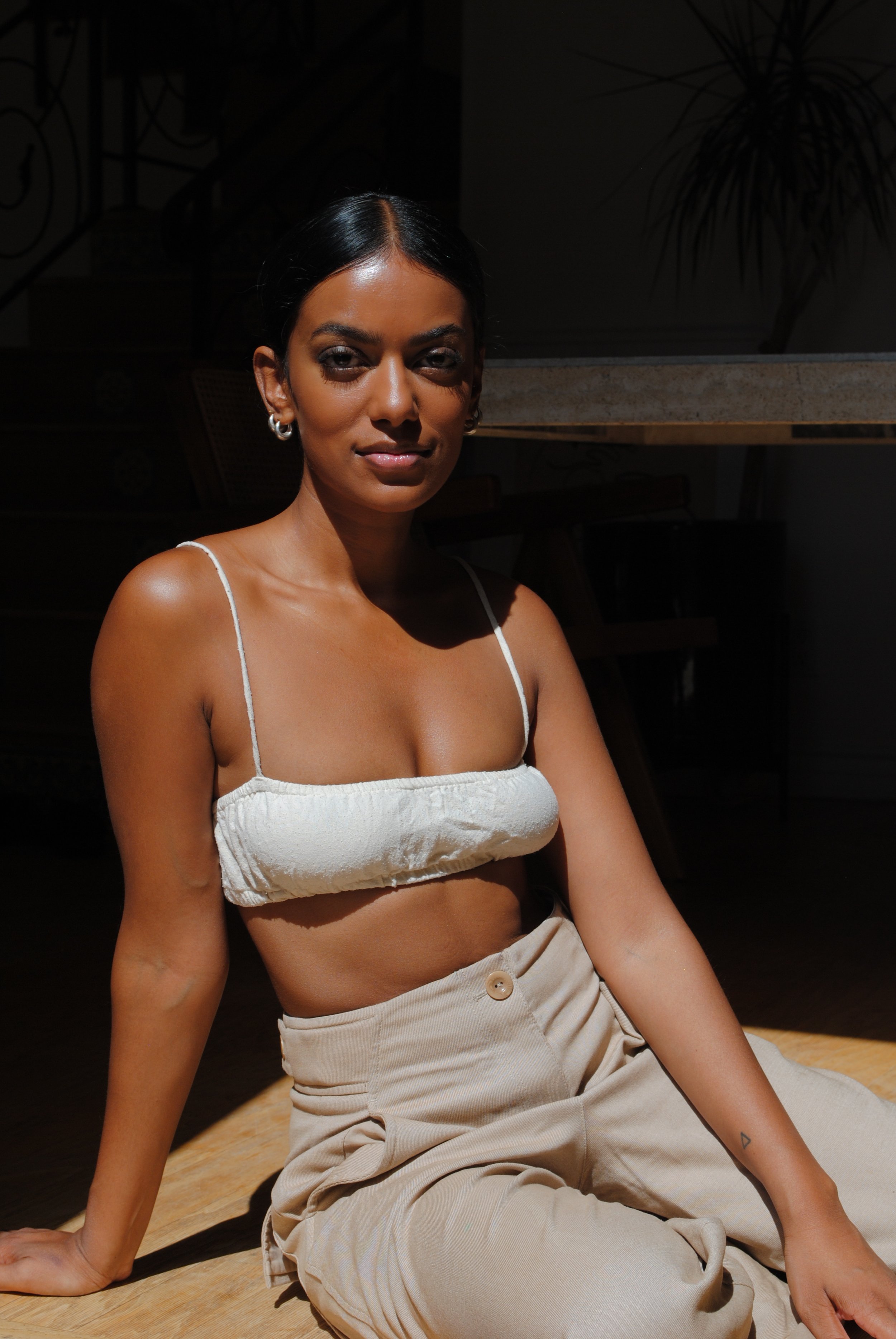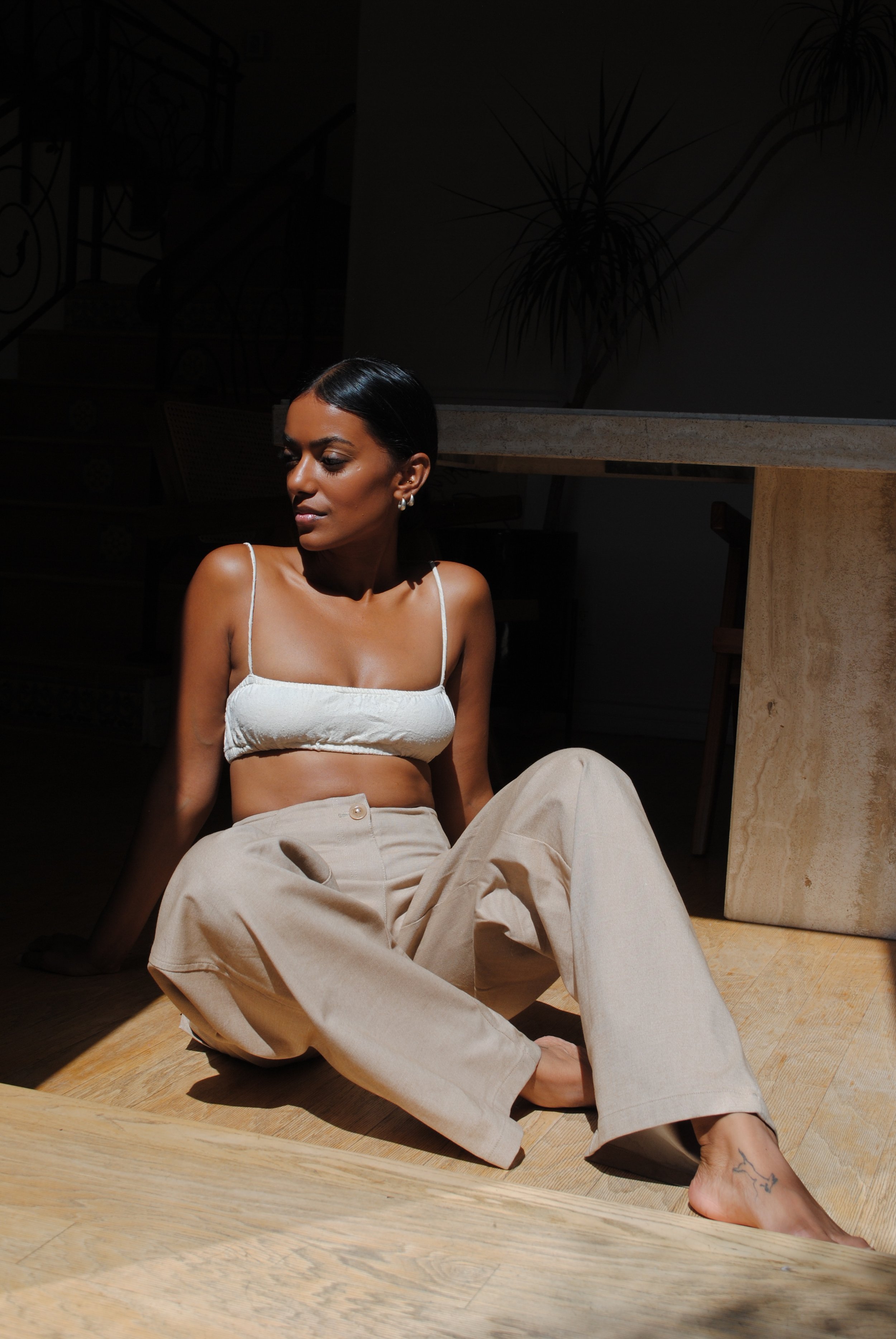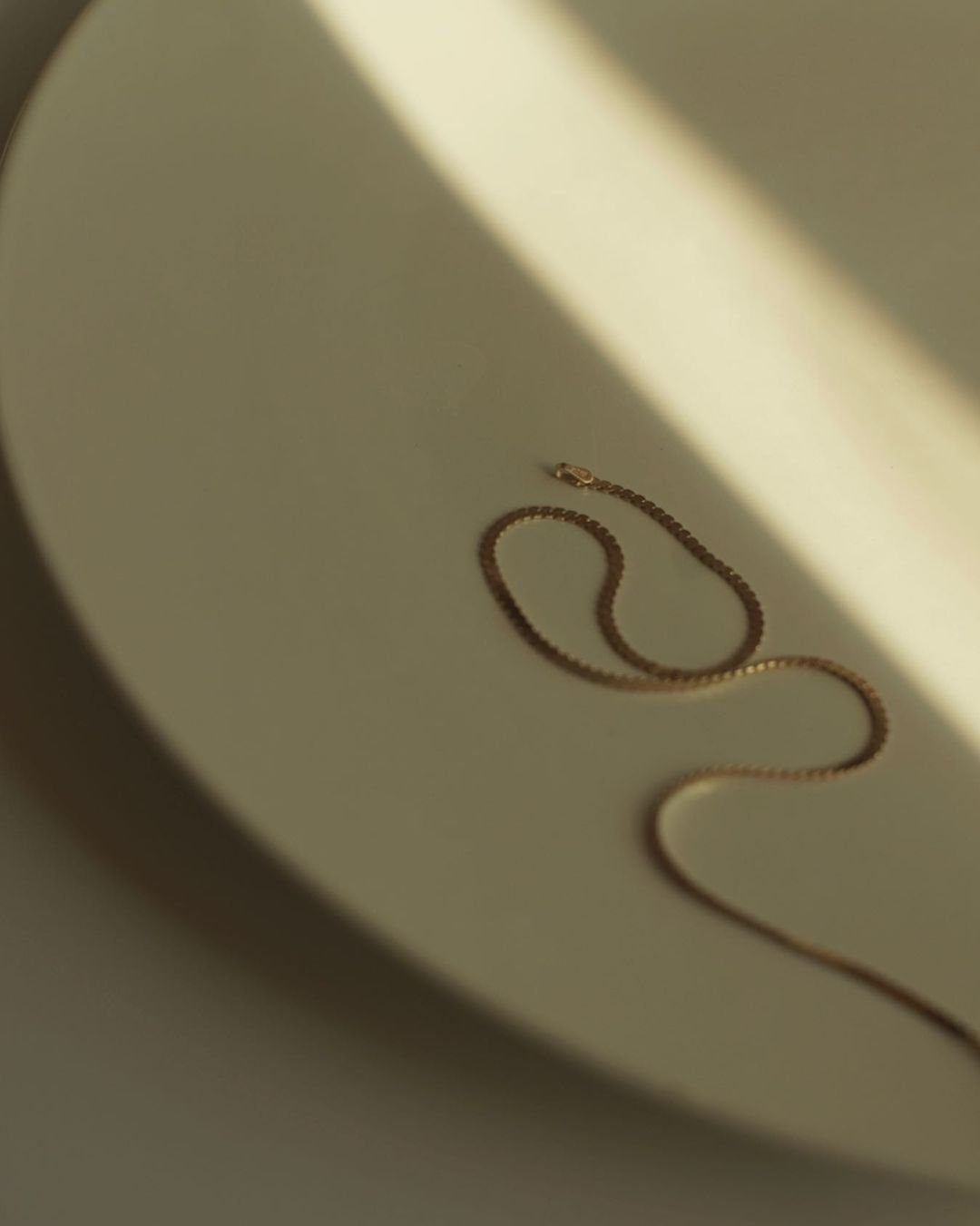Stella Simona
Founder of Haati Chai and Amarilo, Stella Simona is a Bangladeshi-American living in LA
Stella was kind enough to invite me to her Hollywood Hills house on a lovely Los Angeles morning – her home is curated in a minimalistic yet tasteful way, just like her jewellery. Jazz played in the background as she spoke to me in style, sharing personal anecdotes that are a true window into her multifaceted life.
A Bangladeshi-American mother of two babies, Noah and Liam, as well as the founder of two jewellery brands: Haati Chai and Amarilo, meet Los Angeles native Stella Simona.
Tell me about your family
My mother’s family is originally from Kolkata. My great grandfather (Nana's dad) was a prominent senator during the British Raj. After the British presence in the country and all the political turmoil, my family began to migrate to another region which eventually became Bangladesh. My mom grew up in Khulna, and in the late 80s, her siblings, parents, aunts, uncles, and cousins all eventually settled in Los Angeles.
My father’s side is from a very small town called Alipur which is in the Khulna division of Bangladesh. As far back as he can remember, this is where his family has been. He was a successful doctor back home, and when he migrated to the U.S. after marrying my mother, he went through med school a second time. My dad left his whole family to come to America for a better life for his future family (my sister and I), as well as to support his family back home since he is the eldest of 8 siblings.
Although I was born and raised in America, I spent all the years until I was 12 surrounded by family and extended family on the weekends. As an adult, not a week goes by where I haven’t craved Maach Bhaji, bhaath(rice), some aloo bortha (mashed potato), and of course, daal. And years later, I can’t help but want to watch at least one long Bollywood film on a lazy weekend afternoon. Like many first gen individuals, our definition of “home” is a beautiful blend of our native culture and the world we experience every day.
Tell me about your jewellery brands
They’re both 10 years old. Haati Chai is the brand that I originally founded - Haati means elephant, and Chai means tea in Bangla, as well as in a couple of other native Indian languages. I named the brand after two things that I naturally gravitate towards. If you walk around my house, you'll see little elephants everywhere and tea or teapots. The brand came about through me wanting to pay homage to my culture - I really wanted my personal story to come through, so Haati Chai is my own interpretation of East meets West. That's how I grew up. Amarilo is my co-founder Ali's brand, which she originally founded. She's a first-generation Korean-American, and she’s also an adoptee, so her journey with her own identity is heavily explored within the brand. Amarilo consists of classic designs brought to life in a modern way. They’re versatile pieces that can be worn by anyone, whether they’re going out for dinner or to work.
How did you think of starting your own jewellery company?
Jewellery has pretty much been my first love language since I was a kid. My naani (maternal grandmother), who I grew up with, would go back home to India and Bangladesh every summer, and she would bring all of us back different things - dolls, textiles, jewellery, etc. - pieces that represented our culture. I loved everything that she brought me, but the thing that I was always drawn to the most is the packages of jewellery. She would tell me the story of how she found it and how it's made. I was always infatuated by it.
I grew up in the valley, and I was the only kid that looked like me. It was really hard sometimes to communicate with my peers or relate to them, but despite how shy of a child I was, I always went to school wearing these bold pieces of jewellery with my simple school uniform. And it became a conversation starter. The other kids would comment on how beautiful my choker was or how stunning my ring looked. They’d ask me different questions, and I would take it as an opportunity to share the backstory of our culture. It became my way of communicating to my peers that we are more alike than we are different.
Tell me more about how storytelling as a method of narration is complementary to your jewellery
When it comes to the saris we wear, the different pieces of objects that we have in our homes and of course the jewellery we make, each one signifies special moments or phases in our lives - when we got married, coming of age stories, or that time you treated yourself to a piece of jewellery just because. As we put these pieces of jewellery on, we think of where we were at that time and where we are now. A lot of pieces are also passed down to us, and they really make us feel comfortable in our identities. I've always seen jewellery in that way, and I really felt that in the Western world, people started losing touch with that, or they were never in touch with that to begin with. With Haati Chai, specifically, I really wanted to capture that idea and that’s the narrative we always push - to not only share that experience but also to encourage others to find themselves and wear who they are proud.
Can you elaborate on the idea of heirloom jewellery as the basis of your work
Growing up, my grandma would be cooking, and she always had these bangles on. They’d be dangling and making these beautiful noises. I would ask her: why do you always have these on, and how did you get these? She told me about how my grandfather gave her some and some were from her sisters. And she’d tell me that eventually, when she’d pass away, she’d give one to me, one to my mom, one to my sister. My grandma has since then passed, and we acquired the pieces. When I get ready and I put on one of her pieces, it’s always a very emotional moment - I tend to feel much closer to her and much more powerful as a person because I’m carrying these beautiful stories and histories with me. Especially as a minority, a lot of our history tends to get lost, so I love knowing that I’m keeping it alive.
You mentioned this East meets West idea - can you tell me about how you play with your heritage and your places of residency?
It's a marriage of my two worlds in the sense that I’ve found ways to wear some of the most elaborate pieces and incorporate some of the most sacred elements into more minimal everyday wear. A lot of times our jewellery can be super heavy, traditionally speaking, so I'll just make the same type of earring but simplify the weight of it.
Do you, and if so, how do you maintain sustainable production and ethical manufacturing?
I love this question. I’ll be really honest, it's very difficult in any genre of any industry to be 100% sustainable and to be 100% aware of it. We do our best to make sure that we take the proper steps to be as sustainable as we can, like having most of our production in the US, so we can have a better overview. The majority of our materials are 100% recycled gold. We do our best to source our stones only from vendors that we've been working with for a very long time. And in terms of our packaging, we make it a point to be as minimal as possible.
Additionally, the jewellers we work with out here, to help with our production, are second, third and fourth-generation jewellers. This is a practice that’s passed down, but it’s a dying craft because fast fashion is taking over the world in the most horrendous ways. It’s also causing many to not value what these talented and dedicated jewellers do, so their work is getting lost in the mix. Preserving that craft is also a part of our ethical standpoint.
Do you have a target audience within your work, like a certain community that you’re catering to or trying to engage with?
It's more broad than specific - I really don’t like this idea that jewellery made by a South Asian woman is made only for South Asian women to wear. We, over the years, have developed a really strong community of people who understand and appreciate art, because, at the end of the day, that is what jewellery is too. Our community consists of people that really resonate with something that's one of a kind, people that are well travelled and many that are part of a diaspora.
What are some issues or stereotypes that you believe need to be addressed and dismantled in regards to being multicultural?
Allowing us to tell our own stories is very important, as opposed to people seeing us and deciding this is who you are, this is how far you're going to get, and this is what you should be. That's one of the biggest issues we face: we get boxed into certain places, making it harder to develop ourselves in whatever industries/environments we're trying to go into because people already have made their own assumptions. We don't get the same starting point. We consistently have to prove others wrong. I found myself in many areas of my life, making sure that I'm 100% overqualified before I even consider a new idea, because I just want to know that if I am rejected, or if it doesn't work out, it wasn't because I didn't give him my best, it was because of something else.
What do you hope people will take away from your jewellery lines?
The way the world moves, it's too quick. It's designed in a way in which we don't feel comfortable in ourselves, we don't feel confident enough to trust our instincts. I want people to experience a slowness, a deep, fresh breath of air, that will move past the piece of jewellery and seep into other aspects of their life, ultimately making them feel more full and fulfilled. So that they can do better at their jobs, they can be the best parents, they can be the best friends, they can pursue what really is within them, rather than feel like they have to follow the pace of everybody else.
How does your work allow for you to express yourself or maybe even further explore your identity/heritage?
I started working on Haati Chai and Amarilo in my 20s, and they both really helped me dive deep into a mode of self-discovery. I was able to really acknowledge both sides of myself - the western and the native. I was able to kind of rewrite what the years before had done to me. I’ll be forever grateful for that.
What does community mean to you?
My line has allowed me to meet a lot of different people who are in the creative space. Not just the East Indian diaspora, or the South Asian one, but people from all sorts of minorities. My co-founder, being she's a first-generation Korean American, also was very much going through a big period of self-discovery. Watching her explore her cultural foods and learn her language, all in all becoming more comfortable with herself, it came to my surprise that there’s so much more overlap in our cultures than I expected. That taught me that you’ll find community in unexpected places, that the community lines aren’t as rigid as we think. It doesn’t always have to be about finding people that look like you. Sometimes it’s really just finding those that are seeking to do more and do better, to go on a journey.
I think sometimes, because of auntie culture, our instinct is to nit-pick at each other, but I want to change that. We need to support each other! A good friend of mine once gave me the best advice, it’s something I really try to live by on a daily basis: if you can’t support them closely, support them from afar. There’s no reason to compete. One of the best ways of getting past some of the barriers that we are continuously experiencing as minorities are by coming together. And for me, a lot of that means having open discussions. Something I think about often is that our collective idea of beauty is very broken. As an example, there are so many different faces of brown people, but there are only a few types of features and colours that people identify as South Asian. We need to figure out how to make sure everybody: every shape, every colour, every feature, is understood as equally beautiful.
What moves and inspires you?
I’m very emotionally sensory driven, so if I'm in a space that feels peaceful, that'll leave me feeling a certain way. It can be all kinds of things, it’s just a matter of what evokes something in me. Other than that, the women on my mother’s side have inspired me so much. They dressed in the most empowering ways. They all had different styles, but each one was so unique. And my style, it comes from them - my moms, my aunts, everybody back home. They never tried too hard, and that minimalistic approach stayed with me. Beautiful and bold, yet effortless. I remember my aunt would sit and walk me through it - she’d say: “okay, we did a choker, so we're just going to do a bold lip and everything else is simple. That's it”. I hear that voice every time I’m getting dressed.
Have you visited India or Bangladesh? If so, how have those experiences influenced you as a person and/or the designs and styles that you put forward?
Before the pandemic, I went to Bangladesh to go help with the Rohingya crisis. I was sent out there to help spread, raise and create media awareness through my platforms, but also to do translation work - so many on a global basis still don’t know what's happening. I think many in Muslim parts of the world are aware, but beyond that, it’s very limited. I went with a party of Americans that needed help understanding what was going on, so I was communicating what the people in the camps were saying. We also engaged with others of certain poverty levels, essentially those that live in the slums in Dhaka, speaking to different women and learning about the organization called Concern, who are there to help people in need. They’ll help with job placements, help kids get a better education, but also provide caretakers to watch the kids when their parents are at work, they'll get them clean water, they'll give them the resources to be able to cook and clean, etc. Although they had translators, it was different when I was speaking to the locals - I was able to push back and forth much faster. Since then, we've started donating portions of our proceeds on our site to the organization. It's not for all the jewellery, but certain pieces will receive up to 100%. I also visited Bangladesh two other times as a teenager. Experiencing my parent’s native country then and now, were two very different yet very beautiful experiences. Both left me feeling connected to my roots.
What are your hopes/visions/dreams for the future of Haati Chai & Amarilo?
I see myself being able to dabble in many different spaces. I don't want to limit myself to just working in the jewellery space. I feel like Haati Chai and myself as a brand, I’m very much associated with a specific lifestyle, so I want to approach a lot of different concepts, whether it's home design or even luxury travel experiences. I’ve thought about expanding the Haati Chai space for some time now - it's always been something I want to do. There are certain accessories, such as shoes, clothing and even furniture, that I’ve always visualized but I can’t find anywhere. Whenever that happens, I think this is the sign I’ve been waiting for. I hope to begin soon.
Interview and photography: Naomi Joshi & some supplied by Stella Simone









